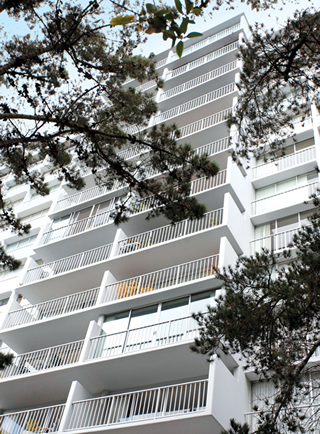City on a Hill - Page 2
 |
|
|
 |
 |
|
|
 |
|
|
But people know their neighbors, and the buildings are beautifully maintained and remain true to the original architecture, at least on the exterior. And in both high- and low-rise, Eichler fans show an increasing appreciation for modern design.
Jung, who snapped up a unit in the tower seven years ago, has emerged as the building’s arbiter of modernity, heading the design committee in its redo of common spaces. And in the Laguna Heights low-rises, says Lois Scott, a longtime resident, younger buyers are showing renewed interest in Eichler style.
Eichler’s original plan was far more ambitious than what ultimately got built. Instead of three towers, only one was built. Other reports have said the plan called for four towers, but only three are shown in an Eichler promotional brochure and only three were cited in Architecture/West. Perhaps earlier plans called for four.
Claude Oakland Associates, which ultimately designed the low-rises, was also to have designed a tower that would have been circular in plan. Jones & Emmons was to design one tower, 66 Cleary Court, the only one that got built. Anshen and Allen was to have designed a third.
Both Jones & Emmons and Anshen and Allen were longtime architects for Eichler. Oakland, an Anshen designer from 1950 until 1960, had just formed his own firm, with associate Kinji Imada, who was a lead designer for the low-rises.
The buildings never became the haven for families Eichler had hoped to see. Over the years, residents of the high-rise and low-rises say, there have been only a handful of children. Colleen Mullins, who grew up at Laguna Heights, recalls, “I got a lot of attention from everybody. I was the cute kid in the building.”
Perhaps, some speculate, Eichler did such a good job at selling the suburbs as an ideal spot for growing families, few wanted to risk living in the city.
Nor did the area turn into the utopia progressive redevelopers had hoped to produce. Virtually none of the neighborhood’s original residents moved back to the new developments. And poverty and crime soon returned and remain problems today.
Residents appreciate the Laguna Eichler high-rise’s 24-hour security. Each building at the Laguna low-rises got locked gates. There are occasional muggings in the neighborhood, and a bullet whizzed through Mullins’ apartment a few years back, leaving a hole in her Philippine mahogany wall.
“It’s not the best neighborhood still,” she says, but adds, “It’s a way nicer neighborhood than it was when I was growing up.”
And Eichler’s ambitions to become a big-city developer clearly proved over-ambitious. The Laguna low-rises (built 1962-1963, at 45, 65, and 85 Cleary Court and 1220, 1250, and 1280 Ellis Street) and the Laguna tower (1963-1964, at 66 Cleary Court) were his first urban developments, but more quickly followed.
By 1962 he was building townhouses at Diamond Heights, near Twin Peaks. Then came Geneva Tower and Geneva Terraces in the southern part of the city, Central Towers in the Tenderloin, and by 1966 his grandest high-rise, the Summit on Russian Hill’s Green Street.




